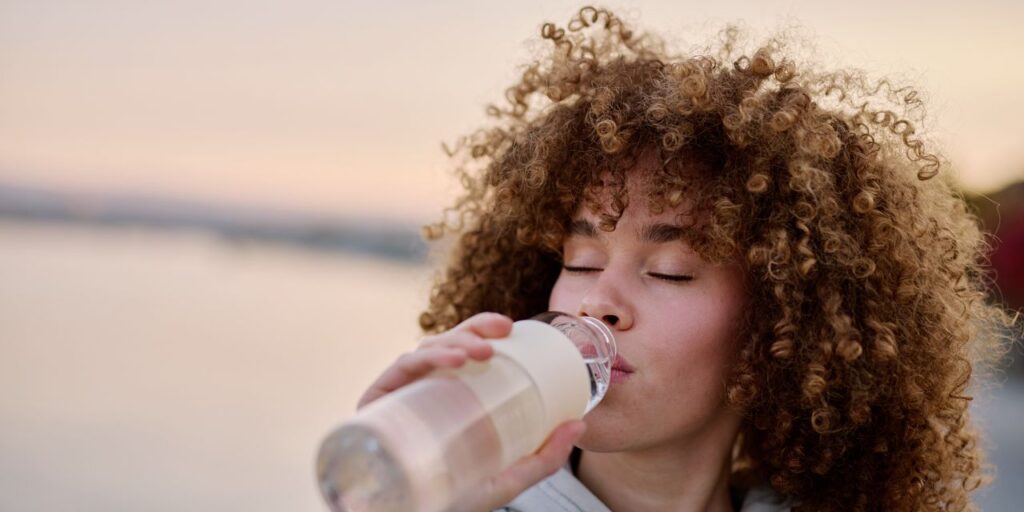What’s more, sugary beverages can also have other health downsides. They can hurt your energy levels by causing the infamous “sugar crash,” Dr. Morgan adds. (To compound the problem, dehydration itself can also make you feel sluggish, so you could be in for a potential double whammy of fatigue.) And routinely overloading on sugar can also raise your risk of metabolic disease in the long term, according to Levi. Instead, use water as your go-to beverage (and if the plain stuff doesn’t appeal, keep on reading).
9. …or those heavy on caffeine or carbonation.
In addition to sugary beverages, you’ll also want to limit carbonated and caffeinated ones, according to Nelson. “Carbonation will make you feel full so you feel like you’ve drunk more fluid than you actually have,” limiting your intake and making it tough to stay adequately hydrated,” she says. The bubbles are also associated with GI issues like bloating and gas as well as dental wear and tear, according to Levi. Meanwhile, caffeine can cause you to pee and poop more, accelerating fluid loss and promoting dehydration. It can also trigger side effects like nausea, shakiness, anxiety, and poor sleep, as anyone who’s ever overindulged knows all too well. Cap your caffeine intake at 400 milligrams or less per day (around two to three 12-fluid-ounce cups, max), Levi recommends.
10. Or, on the flip side, you force yourself to stick entirely to fluids you just don’t enjoy.
The blandness of water can be a big turnoff. Many folks simply don’t drink it often because, well, they don’t like the taste compared to the more flavorful beverages out there—so if tweaking the taste will help, do it! If making that change means you’ll drink more, “that’s a real benefit,” Nelson says.
To impart a light boost, try adding fruit or vegetable infusions, according to Nelson. Per Levi, you can do this by squeezing in some fresh lime or lemon juice, popping in some frozen berries, or adding fresh mint or basil leaves. This way, your H2O will be a bit more palatable (and thus easier for you to swallow, literally), but it’ll still provide all the same hydration benefits. (And a hint for active people seeking more punch in their post-workout beverage: Chocolate milk makes “a pretty good recovery drink,” Nelson says.)
11. You don’t adjust your fluid intake, like, ever.
Your hydration needs aren’t fixed; they can fluctuate depending on your situation. Like we mentioned earlier, “you need more fluids when you’re active or it’s hot out,” Dr. Morgan says, but other risk factors can also boost your hydration needs, like illness. In the event of fever, vomiting, or diarrhea, “we’re going to lose a lot of those fluids, so then we have to replenish them,” Nelson says. Other potential dehydration risk factors include alcohol and some medications, like laxatives, diuretics, and oral meds for type 2 diabetes.
12. And finally, you assume that more is always better.
It’s a classic case of too much of a good thing: “Drinking enough water is essential for steady energy levels and healthy digestion,” but at the same time, it is possible to do it to excess—and even to the point of endangering your health, Levi says. Downing a ton over one to two hours can pose hazards like water intoxication, a.k.a. hyponatremia, the medical term for dangerously low sodium levels in the blood. “Hyponatremia can cause nausea, vomiting, weakness and, in extreme cases, seizures or comas,” Levi says. To be clear, however, these kinds of severe side effects are rare: “You’d likely have to chug a full gallon of water in an hour to be at risk,” she adds. (A more common occurrence? Like we mentioned above, you pound so much at once that your body can’t actually absorb it efficiently.)
So what are the signs that you’ve been a little overzealous in your hydration mission? Clear pee, for one. Just as you can gauge whether you’re dehydrated by the color of your urine—remember, dark yellow indicates you need to drink more—so it can also tell you whether you’re overhydrated. When your, ahem, output has no hue, it’s a sign that you’ve gone overboard.
Related:
Get more of SELF’s great service journalism delivered right to your inbox.


